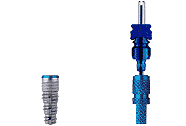|
||||||||||||||||||||||||||||||||||||||||||||||||||
|
Crown production |
||||||||||||||||||||||||||||||||||||||||||||||||||
|
When the gum has healed around the gingiva former or the temporary crown, an impression is made of the implant and jaw. |
||||||||||||||||||||||||||||||||||||||||||||||||||
|
The impression shows the exact spatial relationship between the implant, the tooth arch and the gum. The position of the implant can thus be transformed into a plaster cast. |
||||||||||||||||||||||||||||||||||||||||||||||||||
 |
 |
 |
||||||||||||||||||||||||||||||||||||||||||||||||
|
The impression is made by the use of machinemade transfer copings mounted in the implant with a screw pickup guide pin, whereby an implant analog(a copy) can be placed accurately in the final plaster cast. |
||||||||||||||||||||||||||||||||||||||||||||||||||
 |
 |
 |
||||||||||||||||||||||||||||||||||||||||||||||||
|
The top of the implant analog is surrounded by a gingiva imitation which is an elastic material that will show the shape of the gum and the depth of the gingival pocket around the implant. The abutment for the crown is chosen in accordance with the functional demands, placement in the jaw and esthetic considerations. The abutment is made of titanium or of titanium and ceramics. The crown can be made of porcelain or of porcelain burnt onto a metal jacket. This is how a metal-ceramic crown is made on a straight tooth abutment (4+). |
||||||||||||||||||||||||||||||||||||||||||||||||||
 |
||||||||||||||||||||||||||||||||||||||||||||||||||
|
The axial screw fastens the abutment into the implant. The horizontal screw fixates the crown on the abutment. The horizontal screw may be replaced by cementing the crown onto the abutment. The production of the metal-ceramic crown is made by a porcelain technician who will most often also conduct the choice of colour, in concert with the patient. |
||||||||||||||||||||||||||||||||||||||||||||||||||
 |
||||||||||||||||||||||||||||||||||||||||||||||||||
 |
||||||||||||||||||||||||||||||||||||||||||||||||||
|
The edge of the crown lies on the "shoulder" of the abutment. This "shoulder" is adjusted with a burr so that the edge of the crown is approx. 2mm under the surface of the gum. |
||||||||||||||||||||||||||||||||||||||||||||||||||
 |
 |
 |
||||||||||||||||||||||||||||||||||||||||||||||||
|
The interior metal jacket of the crown is modelled in wax. |
||||||||||||||||||||||||||||||||||||||||||||||||||
 |
||||||||||||||||||||||||||||||||||||||||||||||||||
|
The metal jacket is casted and covered with opaque which is burnt on in 2 layers to prevent the metal shining through the porcelain crown. |
||||||||||||||||||||||||||||||||||||||||||||||||||
 |
 |
 |
||||||||||||||||||||||||||||||||||||||||||||||||
|
The crown is shaped by means of a porcelain mass. Several layers are modelled with dentin-and enamel colours. The porcelain mass hardens in an oven where the temperature rises to approx. 900º C. Two porcelain burnings are made. During the final designing of the crown, the masticating surface is adjusted all the time so that it will fit the masticatory function on the neighbouring teeth. |
||||||||||||||||||||||||||||||||||||||||||||||||||
 |
 |
 |
||||||||||||||||||||||||||||||||||||||||||||||||
|
It is essential to recreate the natural colour variation in relation to the neighbouring teeth. Consequently, nuances are placed into the dentin and enamel structure with internal colours. If the crown is to be removable, a retaining screw is used. A horizontal screw is placed 1 mm over the surface of the gingiva on the oral side of the tooth to hide the head of the screw. |
||||||||||||||||||||||||||||||||||||||||||||||||||
 |
 |
 |
||||||||||||||||||||||||||||||||||||||||||||||||
|
Before the crown is delivered to the patient, a surface firing is made, in order to create a smooth and natural looking tooth surface. |
||||||||||||||||||||||||||||||||||||||||||||||||||
|
Consultation | Pre-treatment examples | Implant placement |
||||||||||||||||||||||||||||||||||||||||||||||||||
 |
||||||||||||||||||||||||||||||||||||||||||||||||||

